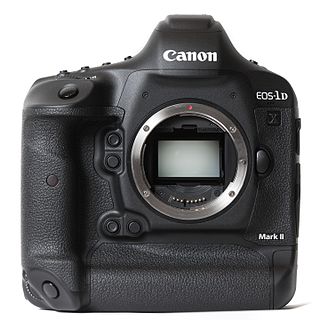Top Qs
Timeline
Chat
Perspective
Canon EOS-1D X Mark II
2016 full-frame digital single-lens reflex camera From Wikipedia, the free encyclopedia
Remove ads
The Canon EOS-1D X Mark II is a 20-megapixel full-frame DSLR flagship camera, announced on February 1, 2016, by Canon with an MSRP of US$5,999.00. It was the successor to the Canon EOS-1D X, which was released in 2012.[3][4]
On January 6, 2020, Canon introduced the Canon EOS-1D X Mark III as the successor to the EOS-1D X Mark II.[2]
Remove ads
Features
Summarize
Perspective
New features over the Canon EOS-1D X are:
- DCI 4K (4096×2160) with up to 60 fps (59.94 fps) up to 29'59" (4K can only be recorded internally in MJPEG, the HDMI output is limited to 1080p)[5]
- Continuous shooting rate of up to 14 frames per second with full autofocus; 16 fps in live view with locked focus and exposure. These rates are available when using the new LP-E19 battery. The EOS-1D X Mk II accepts the LP-E4N batteries of the Mk I and LP-E4 batteries of the 1D Mark IV, but burst mode reverts to the Mk I maximum of 12/14 fps.
- Full HD video (1920×1080) up to 120 fps (119.9 fps)
- All AF points support to a maximum aperture of f/8[6]
- Digital lens optimizer for JPEG shooting.
- AI Servo AF III
- Continuous red illumination of all AF points
- Support for CFast (a variant of CompactFlash) memory cards
- Built-in GPS used for geotag information and syncing to UTC time[7]
- One additional stop of ISO range with it being expandable to 409600
- Anti-flicker feature (introduced with the EOS 7D Mark II) – camera can be set to adjust the moment of exposure to compensate for flickering electric lighting
- A touchscreen LCD, which allows videographers to select the camera's AF point before and during video recording.
- Wi-Fi for wireless file transfer (with wireless transmitter)[7]
Remove ads
Comparison with the EOS-1D X
Summarize
Perspective
Remove ads
See also
References
External links
Wikiwand - on
Seamless Wikipedia browsing. On steroids.
Remove ads

